У меня в последнее время как-то все с первого раза не получается! То ли я ввязываюсь куда-то не туда, то ли устройства попадают ко мне с какими-то ограничениями. Видимо, роутер TP-LINK TL-WR842ND V2 из этого разряда и без трудностей не обошлось, поэтому распишу как сделал и как надо, чтобы в будущем и вам полезно было и я сам не мучил себя вопросом — «Как же я это сделал?»
Для начала…
Чтобы много вопросов не возникало, я быстро распишу, как установить саму прошивку OpenWRT на примере роутера TP-LINK TL-WR842ND V2. Инструкция универсальна, так что у вас тоже должно получиться.
Итак, переходим на эту страницу, спускаемся к таблице и вводим данные о вашем роутере, нажимая ENTER.
В графе Supported Current Release увидим последнюю версию прошивки, которая доступна для вашего роутера. На момент написания этой статьи, для моего роутера это версия 19.07.2. Чтобы скачать прошивку, воспользуйтесь ссылкой в графе Firmware OpenWrt Install URL.
Теперь вам надо поместить в эту же папку ранее скачанную прошивку, но здесь есть один важный момент!
Прошивку необходимо правильно переименовать под вашу версию роутера.
Собственно, название прошивки должно быть следующего вида: МодельВерсия_tp_recovery.bin
То есть, если у меня роутер TP-LINK TL-WR842ND V2, то название прошивки у меня будет: wr842ndv2_tp_recovery.bin
Отключаем на компьютере лишние Ethernet-кабели, а также Wi-Fi адаптер, чтобы ничего не мешало, и подключаемся к LAN порту роутера.
Далее подключаем компьютер к LAN порту роутера и меняем ip адрес сетевого адаптера компьютера на 192.168.0.66.
Для некоторых моделей роутеров ip адрес может быть 192.168.1.66
Все необходимые условия сделаны, давайте теперь прошиваться!
- Запускаем от имени администратора утилиту TFTP-сервер.
- Нажимаем и удерживаем кнопку WPS/Reset на роутере и не отпуская, включаем питание. В таком состоянии держим до той поры, пока не загорится светодиод с замком, примерно 5-10 секунд.
Если все было сделано правильно, то появится окно загрузки. Ожидаем пока процесс закончится, после чего ждем еще пару минут, пока сам роутер не перезагрузится.
При перезагрузке, в основном, загораются все светодиоды.
Если окно загрузки не появляется, то, возможно, вы неправильно изменили название прошивки. Во вкладке Log viewer можно посмотреть какое название прошивки запрашивает сам роутер.
Не забудьте вернуть настройки сетевого адаптера вашего компьютера в режим автоматического получения ip-адреса!
Настройка с помощью веб-интерфейса LuCI
Подключимся и настроим подсеть
После, открываем браузер и переходим на страницу роутера по адресу 192.168.1.1, у некоторых это может быть 192.168.0.1. Думаю, сами разберетесь.
В итоге, откроется страница авторизации, где надо ввести логин и пароль. Так как это первый запуск, то вы увидите предупреждение о том, что на роутере не установлен пароль. Чтобы установить пароль, нажмите на кнопку «Go to password configuration«. Далее ничего сложного, поэтому переходим дальше к более важным настройкам.
Назначим новый ip-адрес вашему роутеру, так как он должен работать в другой подсети от основного роутера. Это важно! У моего основного маршрутизатора 192.168.1.1, поэтому на второй я буду назначать 192.168.2.1.
Нажимаем на Network и переходим в Interfaces.
Находим интерфейс LAN и нажимаем на кнопку Edit.
В поле IPv4 sddress: вводим новый ip-адрес и снизу нажимаем на кнопку Save. После, еще раз нажимаем на кнопку Save&Apply.
После того, как увидим следующее окошко с обратным отсчетом, предлагаю отключить и включить вручную LAN кабель роутера.
Ваш компьютер, возможно, не сразу определит новый ip-адрес роутера, поэтому и предлагается отключить и включить вручную LAN кабель роутера или лучше само питание. После этих действий, открываем новую вкладку браузера и переходим на установленный вами ip-адрес 192.168.2.1, пока обратный отсчет не закончился! Иначе роутер вернет старый ip-адрес.
Если все прошло успешно, должно появиться такое предупреждение.
Иначе, увидим такое предупреждение, где нажимаем на кнопку Apply unchecked, для применения настроек.
Подключимся к интернету
Драйверы, используемые в OpenWRT, лишены поддержки мостового соединения в режиме клиента. Чтобы решить эту проблему, нужно установить дополнительные пакеты, но для этого нужен интернет на самом роутере.
Давайте подключимся по Wi-Fi к основному маршрутизатору, чтобы получить интернет.
Нажимаем на Network и переходим в Wireless.
Находим интерфейс radio0 Generic… и нажимаем на кнопку Scan.
Выбираем сеть Wi-Fi вашего основного роутера, к которому надо подключиться и нажимаем на кнопку Join Network.
В поле WPA passphrase: вводим пароль от сети Wi-Fi основного роутера, а все остальное делаем как на скриншоте, после чего нажимаем на кнопку Sunbmit.
Перед вами откроется страница расширенных настроек Wi-Fi клиента, где вы можете настроить различные параметры по мере необходимости.
В пункте Operating frequency находятся важные параметры, такие как стандарт и ширина канала. Эти параметры должны быть выставлены как на основном маршрутизаторе.
Не забудьте применить настройки! Нажмите кнопку Save, а потом нажмите на Save&Apply.
Если все настройки сделаны правильно, то внизу на открывшейся странице вы увидите статус подключения к основному роутеру в режиме «Client». Также, на вашем компьютере должен появиться интернет.
Установим дополнительные пакеты
Так как у нас уже есть интернет, то сейчас будем устанавливать необходимые пакеты, такие как luci-proto-relay и relayd, а заодно и установим пакеты русского языка.
Нажимаем на System и переходим в Software.
Находим и нажимаем на кнопку Update lists.
Ждем, пока не обновятся все пакеты, жмем кнопку Dismiss, после чего находим строку Download and install package:
и устанавливаем по очереди ниже указные пакеты:
luci-proto-relay
relayd
luci-i18n-base-ru
luci-i18n-firewall-ru
В окошках нажимаем на кнопку Install и ждем пока не появится что-то подобное.
Ну вот и все, все пакеты установлены, обновляем страницу и интерфейс теперь на Русском языке, что еще для счастья надо.
Настраиваем раздачу Wi-Fi
Раз мы установили русский интерфейс, то дальше буду ориентировать вас в русском меню.
Нажимаем на Сеть и переходим в Wi-Fi.
Находим интерфейс с SSID OpenWrt с режимом Master, после чего нажимаем на кнопку Изменить.
Теперь перед нами страница настроек Wi-Fi мастера. Здесь необходимо задать параметры, как у основного маршрутизатора.
Расскажу об основных настройках.
Мощность передатчика — лучше настроить так, чтобы при приближении к основному роутеру, устройство автоматически меняло сеть подключения.
Режим — должен стоять как «Точка доступа».
ESSID — видимое название WI-Fi сети (имя сети).
Шифрование — находится во вкладке Безопасность беспроводной сети, нужно для того, чтобы установить пароль на Wi-Fi сеть.
Сохраняем кнопкой Сохранить и нажимаем Сохранить и применить.
Настроим интерфейс повторителя
Теперь добавим и настроим интерфейс Relayd(Мост-ретранслятор), чтобы присоединить интерфейсы lan и wwan.
Нажимаем на Сеть и переходим в Интерфейсы.
Находим и нажимаем на кнопку Добавить новый интерфейс.
В разделе имя вводим Repeater_bridge, а протокол выбираем Мост-ретранслятор, после чего нажимаем на кнопку Создать интерфейс.
Откроется страница настроек нового интерфейса, где надо будет проделать некоторые настройки.
В разделе Основные настройки должно быть так:
-
Протокол должен быть Мост-ретранслятор.
-
Ставим галочку, чтобы загружалось при запуске.
-
Открываем список в пункте Ретранслятор между сетями и обозначаем в списке lan и wwan.
-
Локальный IPv4 — адрес здесь выставляем IP- адрес, который был ранее назначен на Wi-Fi-сеть.
Переходим на вкладку Настройки межсетевого экрана и выбираем lan. Нажимаем кнопку Сохранить, а после — Сохранить и применить.
Перезагружаем роутер самостоятельно, нажимаем на Сеть и переходим в Wi-Fi. Почему-то у меня отключился Master Wi-Fi, поэтому проверьте эту настройку и, если необходимо, включите и сохраните настройки с применением.
Настройка с помощью CLI
Пока времени не хватает, чтобы расписать как настроить тоже самое с помощью CLI, но как время появится, я обязательно это сделаю.
Октябрь 16.2019
В данной статье мы рассмотрим настройку роутера под управлением ОС OpenWRT в режим сетевого моста. Интернет наш роутер будет получать по Wi-Fi от другой сети и раздавать по LAN и собственной сети Wi-Fi.
- Вам потребуется знать в какой подсети находится роутер, от которого мы будем получать интернет. Чтобы узнать подсеть, подключитесь по LAN или Wi-Fi к роутеру, затем зайдите в Центр управления сетями и общим доступом — Изменение параметров адаптера — щелкните правой кнопкой мыши на подключении — Состояние — Сведения. В нашем случае роутер находится в подсети 192.168.0.0/24
- Подключитесь к web-интерфейсу роутера OpenWRT
- Сначала нужно объединить подсети двух роутеров и отключить DHCP. Заходим в раздел Сеть — Итерфейсы. Нажимаем кнопку «Редактировать» LAN интерфейс
- В поле IPv4 адрес вводим свободный IP адрес из подсети роутера с интернетом.
- Отключаем DHCP, поставив галочку «Игнорировать интерфейс» в разделе DHCP-сервер. Нажмите «Сохранить и применить»
- Чтобы снова подключиться к WEB-интерфйсу, перейдите к настройке IPv4 параметров вашего сетевого адптера. Пропишите компьютеру свободный IP адрес подсети. В качестве шлюза укажите IP-адрес роутера с OpenWRT
- Подключитесь к WEB-интерфейсу через новый IP-адрес роутера. Перейдите в меню Сеть — Wi-F и нажмите кнопку «Сканировать»
- Найдите в списке нужную Wi-Fi сеть и нажмите «Подключение к сети»
- Пропишите пароль Wi-Fi сети и назначьте зону межсевого экрана — WAN, нажмите кнопку «Применить»
На этом настройка сетевого моста завершена.
If supported by both devices, consider using WDS, Layer 2 GRE tunnels (“gretap”), or mesh networking.
Using relayd as instructed in this article isn’t guaranteed to work with all Openwrt compatible devices or wifi networks.
The most common problem is that the client router cannot pass the DHCP message between the main router and the client connected to the client router. Currently it seems to be the hardware/SOC limitation (related to MAC cloning?)
Instead of relayd it should be possible to use kmod-trelay, the only information about using it can be seen in its source code, if you used it successfully please add a section for it in this article.
In this article you will see how to configure your device to become a Wi-Fi extender/repeater/bridge.
In some cases, the wireless drivers used in OpenWrt do not support “Layer 2” bridging in client mode with a specific “upstream” wireless system. When this occurs, one approach is to route the traffic between LAN and the upstream wireless system. Broadcast traffic, such as DHCP and link-local discovery like mDNS are generally not routable.
When other options don’t work, the relayd package implements a bridge-like behavior for IPv4 (only), complete with DHCP and broadcast relaying. This configuration can be done through SSH (remote terminal) or through Luci GUI.

This image shows an example setup. LAN interface of the relayd device MUST be on a different subnet for relayd to work (since it is routing traffic, it expects 2 different subnets).
Since both ethernet ports and Access Point Wi-Fi network are on the same LAN interface, all clients connecting to the Ethernet ports and to the Access Point Wi-Fi network of the Wi-Fi extender device will be routed by relayd and will be connected to your main network.
The LAN interface subnet will be used only as a “management” interface, as devices connecting to the Wi-Fi repeater will be on the main network’s subnet instead. If the relayd device becomes unreachable, you will have to configure a PC with a static address in the same subnet as the LAN interface (eg. 192.168.2.10 for our example) to connect and be able to use LuCI GUI or SSH.
relayd package is of course needed, and luci-proto-relay is optional for the LuCI Web Interface.
Disconnect this router from your main network after successfully installing the above packages.
Alternatively, follow the steps described below to install the relayd packages over the new wwan wireless link.
Updated with new screenshots from OpenWrt 21.02.
To build a simple Wi-Fi repeater (a device that extends the same Wi-Fi network’s coverage) it’s a good choice to use the same Wi-Fi network name (SSID) as the one of your main router along with encryption, password, and so on. This ensure the wireless devices connected to your (wider) network will automatically stay connected to the best Wi-Fi network.
Alternatively, you can also choose to have a different SSID name/encryption/password.
Setting up a Wi-Fi network at this stage is not necessary if you just want a “Wifi bridge”. ie. a device designed to only connect ethernet devices to your existing Wi-Fi network.
For simplicity and best chance of success, the instructions below are only for setting up a Wifi bridge device. A computer with an ethernet connection is required.
LAN Interface
As shown in the above image, the LAN interface must be set in a different subnet than the Wi-Fi network you are connecting to.



When you finish all of the following steps, remember to reset your PC’s IP address back to the original address (or DHCP), otherwise you won’t have Internet access! (note: The router won’t route traffic from the 192.168.2.0/24 subnet)
Wi-Fi
We will now set up the client Wi-Fi network, the configuration needed to connect to another Wi-Fi network.
You will land in the client Wi-Fi settings page. Edit as required.
The most important settings are on the Operating Frequency line.
Removing redundant WAN interface and firewall zones (Optional)
Although not absolutely necessary, it is recommended to delete the redundant WAN interfaces and firewall zones.
Click Save & Apply button.
Warning: These actions will also automatically remove any redundant firewall traffic and port forwarding rules.
Configure static IP address on wwan interface
It is recommended to assign a static IP address to newly created wwan interface. (eg. 192.168.1.30)
The main advantage is it will be possible to manage the router using this static IP address.
This static IP address will also be used later when creating the Relay interface.

Testing Connection
To verify the newly configured static IP address parameters are valid,
Installing relayd package
Creating Relay Interface
To add the relayd interface that will join/bridge the lan and wwan interfaces.



Reminder: Remove the static IP address from your computer. ie. change it back to DHCP client mode.
When the Wifi bridge is powered up, your computer should acquire DHCP IP address from your main router.
The Wifi bridge can be managed through its static wwan IP address (eg. 192.168.1.30)
This is the final result. Note how the client network has a ? instead of a IP address.
The wwan IP address is only visible in the Network Interfaces page.
Check Firewall zone settings
The following part of the configuration should not be necessary (already default options or changed automatically), in case something isn’t working check this too.
—-
Before doing any actual configuration, the Wi-Fi interface must be enabled in order to scan for networks in the vicinity:
uci set wireless.@wifi-device[0].disabled="0" uci commit wireless wifi
Now we can list networks in range using iw dev wlan0 scan, substituting your actual wireless interface for wlan0 if different (ifconfig lists all available interfaces to find how your wlan is called)
iw dev wlan0 scan output example:
# iw dev wlan0 scan BSS c8:d5:fe:c8:61:b0(on wlan0) -- associated TSF: 24324848870 usec (0d, 06:45:24) freq: 2412 beacon interval: 100 TUs capability: ESS (0x0411) signal: -72.00 dBm last seen: 140 ms ago Information elements from Probe Response frame: SSID: Violetta RSN: * Version: 1 * Group cipher: CCMP * Pairwise ciphers: CCMP * Authentication suites: PSK * Capabilities: 1-PTKSA-RC 1-GTKSA-RC (0x0000) BSS f8:35:dd:eb:20:f8(on wlan0) TSF: 24225790925 usec (0d, 06:43:45) freq: 2457 beacon interval: 100 TUs capability: ESS (0x0431) signal: -90.00 dBm last seen: 1450 ms ago Information elements from Probe Response frame: SSID: GOinternet_EB20FB HT capabilities: Capabilities: 0x11ee HT20/HT40 SM Power Save disabled RX HT20 SGI RX HT40 SGI TX STBC RX STBC 1-stream Max AMSDU length: 3839 bytes DSSS/CCK HT40 Maximum RX AMPDU length 65535 bytes (exponent: 0x003) Minimum RX AMPDU time spacing: 4 usec (0x05) HT RX MCS rate indexes supported: 0-15, 32 HT TX MCS rate indexes are undefined HT operation: * primary channel: 10 * secondary channel offset: below * STA channel width: any RSN: * Version: 1 * Group cipher: TKIP * Pairwise ciphers: TKIP CCMP * Authentication suites: PSK * Capabilities: 1-PTKSA-RC 1-GTKSA-RC (0x0000)
In the example, there are two networks, a Wi-Fi g one called Violetta and a Wi-Fi n one called GOinternet_EB20FB.
The device was configured to connect to the one called Violetta.
These are the uci values that were added or changed by the configuration procedure.
For SSID, BSSID, and encryption you must use the info you got from the Wi-Fi scan above.
For an explanation of why these values were changed, please read the luci tutorial above.
network.lan.ipaddr='192.168.2.1' network.repeater_bridge=interface network.repeater_bridge.proto='relay' network.repeater_bridge.network='lan wwan' network.wwan=interface network.wwan.proto='dhcp' firewall.@zone[0].network='lan repeater_bridge wwan' dhcp.lan.ignore='1' wireless.radio0.hwmode='11g' wireless.radio0.country='00' wireless.radio0.channel='1' wireless.radio0.disabled='0' wireless.@wifi-iface[0]=wifi-iface wireless.@wifi-iface[0].device='radio0' wireless.@wifi-iface[0].mode='ap' wireless.@wifi-iface[0].encryption='none' wireless.@wifi-iface[0].ssid='OpenWrt' wireless.@wifi-iface[0].network='lan' wireless.@wifi-iface[1]=wifi-iface wireless.@wifi-iface[1].network='wwan' wireless.@wifi-iface[1].ssid='Violetta' wireless.@wifi-iface[1].encryption='psk2' wireless.@wifi-iface[1].device='radio0' wireless.@wifi-iface[1].mode='sta' wireless.@wifi-iface[1].bssid='C8:D5:FE:C8:61:B0' wireless.@wifi-iface[1].key='myWifiPasswordHere'
Please note that the Wi-Fi network generated by the device in this example (the one called OpenWrt) has no password nor encryption.
This was done because the focus of this article was getting the relay bridge up and running.
You will likely want to set up your device’s Wi-Fi network in a more secure way, as explained in the Wi-Fi setup page here.
If you find the OpenWrt device itself is only accessible from those computers directly connected to the W-LAN AP, not from the ones connected to the OpenWrt W-LAN client, when in the 192.168.1.0 subnet, Make sure the Local IPv4 address setting in the Relay bridge interface matches the ip address of the wireless uplink.
(The alternative is tedious: It is possible to access the OpenWrt box via its 192.168.2.1 address if you manually configure your computer to that subnet.)
Activate IPv6 support on your Internet box, this will get you a public IPv6 prefix. We will now activate IPv6 on our Wi-Fi extender to allow for Stateless Address Autoconfiguration (SLAAC) of your public IPv6 addresses and IPv6 traffic.
1. Go to Network / Interfaces and create a new interface. Name it WWAN6, using protocol DHCPv6, cover the WWAN interface. In the Common Configuration of the new interface, configure: Request IPv6 address: disabled. In the Firewall settings: check that the “lan / repeater bridge…” line is selected. Leave the other settings by default, especially, leave the “Custom delegated IPv6-prefix” field empty. On the Interfaces / overwiew page check that the WWAN interface gets a public IPv6 address.
2. Edit the LAN interface settings, DHCP server / IPv6 settings: check/modify the following settings: Router Advertisement Service: relay mode, DHCPv6 service: disabled, NDP-Proxy: relay mode.
3. Open a SSH session on your OpenWrt device. Issue the following commands:
uci set dhcp.wan.interface=wwan uci set dhcp.wan.ra=relay uci set dhcp.wan.ndp=relay uci set dhcp.wan.master=1 uci commit
We suppose that you created a wwan interface when you joined to the other Wi-Fi network as suggested earlier in this guide; otherwise, change the dhcp.wan.interface=… line accordingly.
That’s it. Restart ophcpd (LuCI System/Starup page, or /etc/init.d/odhcpd restart) and your IPv6-network should begin to configure itself. Connected IPv6-enabled devices should get their public IPv6 addresses, derived from your public IPv6 prefix, and IPv6 traffic should go through your Wi-Fi extender.
Here are a list of some recently reported issues:
-
DHCP issue caused by Access Point. OWrt forum
-
Additional instruction for backdoor to router since once dhcp is disabled on LAN, the router become unreachable. This may occur if there are changes to the wireless access point. eg. wifi SSID, channel number or security passphrase has changed.
-
Connect a computer using ethernet cable to LAN port of the Wifi bridge.
-
Configure a static IP address on the computer. eg. if the Wifi bridge uses LAN IP address of 192.168.2.1 in above example, use static IP address: 192.168.2.10.
-
Access LuCI at 192.168.2.1 for above example.
-
Comment: This looks like the basic instructions for configuring a simple wireless client
This method basically puts a second Wi-Fi router in cascade on the first one; i.e. usually this means that the extender’s clients will be behind double NAT.
It’s like connecting with a cable the WAN port on the Wi-Fi extender to the LAN ports of the main router, the Wi-Fi extender creates a new network for itself and the devices connected to it, that can go on the Internet and reach devices in the LAN network of the main router. But in this case we are doing it with wireless networks instead.
prerequisites:
— router with two initial interfaces (LAN, WAN)
Setup with WebUI:
Now you’ve correctly bounded WWAN with WAN, and consequently WWAN with LAN.
Some time ago I had to connect a device to my network that could be only connected via network wire. Unfortunately there was no access to a switch or something similar nearby. But my network (of course) has a wifi access point that my device could connect to if it would have a wifi adapter.
So how could I connect my device to the network as if it was connected by wire? It should behave just like a normal network client and for example get an ip address via DHCP, have the ability to connect to other LAN clients etc.
Solution is easy & very cheap. A (almost) transparent LAN/WLAN bridge!
Read on to see how you could setup such a bridge easily using a GUI (LuCI).
Notes
What we setup here is basically a routed client as described here: https://wiki.openwrt.org/doc/recipes/relayclient. It is called a pseudobridge in the article because technically it is a router pimped by some software to act like a bridge.
Whenever I refer to the ‘router’ I mean the TP-Link TL-WR841N device we are working on and not some router that may exist in your network.
Hardware
For my solution I use the very cheap and simple router TP-Link TL-WR841N. On this device you can easily install the custom firmware that we will need.
The TL-WR841N I am using here works pretty well for this setup but is not recommended by OpenWrt anymore due to low flash/ram. So in case you want to upgrade to a newer version of OpenWrt in the future choose a device with more flash/ram.
Prerequisites
In order to be able to do the setup you need a few things:
- A working access point that has access to the internet
- A desktop/notebook with an SSH client (e.g. PuTTY)
- A network cable to connect desktop/notebook to the router
1. Install custom firmware (OpenWrt) on router
There are many very good tutorials how to install the custom firmware OpenWrt on a TL-WR841N. Therefore I am not describing this step.
I recommend sticking with the install instructions on the OpenWrt-Website, which in my case was: https://openwrt.org/toh/tp-link/tl-wr841nd#installation
For this tutorial I used release 18.06.04 of OpenWrt.
2. Reset (optional)
If you just installed the custom firmware you may ommit this step. But if you already twiddled with it or need to reset because you messed something up, just do this:
- Power off the device
- Remove all cables (except the power cable of course)
- Press the reset button and keep it pressed
- Power on the device (keep the reset button pressed)
- Watch the status LEDs (keep the reset button pressed)
- The lock LED turns on (keep the reset button pressed)
- The lock LED turns off (keep the reset button pressed)
- The lock LED starts blinking (keep the reset button pressed)
- The lock LED starts to illuminate constantly
- Immediately release the reset button
- The device now resets to OpenWrt default configuration. During this process all LEDs may blink
- Wait till the lock LED illuminates constantly again
Now your device is reset to OpenWrt defaults and we can start to configure our LAN/WLAN bridge.
3. First steps
- Connect your desktop/laptop via network cable to the router using port 1
- Ensure, that your computer isn’t connected to any other network, e.g. via WLAN
- On your computer enable DHCP for your ethernet device
- On your computer open a browser window and visit http://192.168.1.1 which is the GUI/frontend of your OpenWrt router
- Initially there is no password set, so be sure there is no password in the password field and click Login
4. Set your password
- In the menu go to System/Adminstration
- Choose a password and enter it in the fields Password and Confirmation
- At the bottom of the page press Save & Apply
5. Set the ip address of your router
Your router needs to have an ip address that is outside of your LAN. Otherwise the bridging will not work. This will also be the address you have to use when you need to configure your router. So just choose an ip address that you normally never would use and you are save 😉
I chose 192.168.15.1 for my router as the whole subnet 192.168.15.0/24 isn’t yet used. If you choose another address remember to replace 192.168.15.1 in every part of this guide.
- In the menu go to Network/Interfaces
- For the interface LAN click on action Edit
- In the field IPv4 address enter your new ip address, in my case 192.168.15.1
- Because the bridge should be transparent, we have to disable the DHCP server. Therefore find the DHCP section and check the Ignore Interface option
- Click Save & Apply
- In current versions of OpenWrt you get a “Configuration has been rolled back!” alert which is because of the changed ip address your browser and the router cannot communicate anymore. This is perfectly normal. Please just click Apply unchecked and wait till the (also normal) “Device unreachable” message appears.
From now on your router is reachable with its new address 192.168.15.1. Because we disabled the DHCP server your computer will not get a new ip address automatically. You have to set it manually now:
- Give your computer a new ip address that belongs to the new subnet. I gave the ethernet adapter of my notebook the ip address 192.168.15.2 and netmask 255.255.255.0
To resume configuration you have to reconnect to the router now.
- In your web browser go to http://192.168.15.1 which is the new URL of the router frontend
- Login in with username root and your password
6. Remove unneeded wireless connection
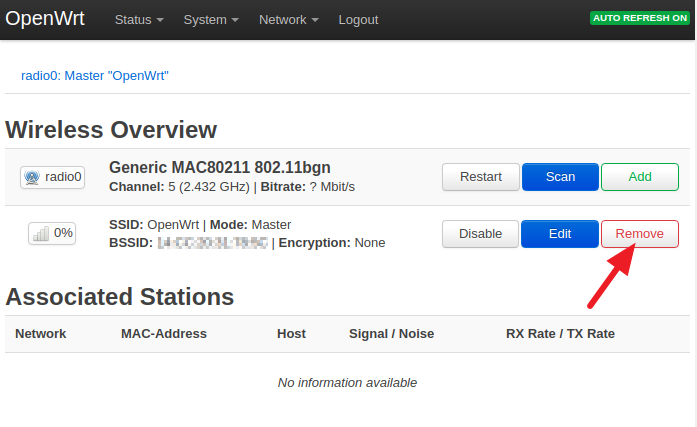
- In the menu go to Network/Wireless
- Find the connection with SSID “OpenWrt” and mode “Master”.
- Click Remove
- Confirm removal in the popped up dialog
7. Connect router to your WLAN
- In the menu go to Network/Wireless
- Click Scan in the upper right
- When the scan is finished choose the network you want to join and click Join Network
- In the appearing dialog enter the passphrase of the WLAN you want to join
- Click Submit
- Click Save & Apply
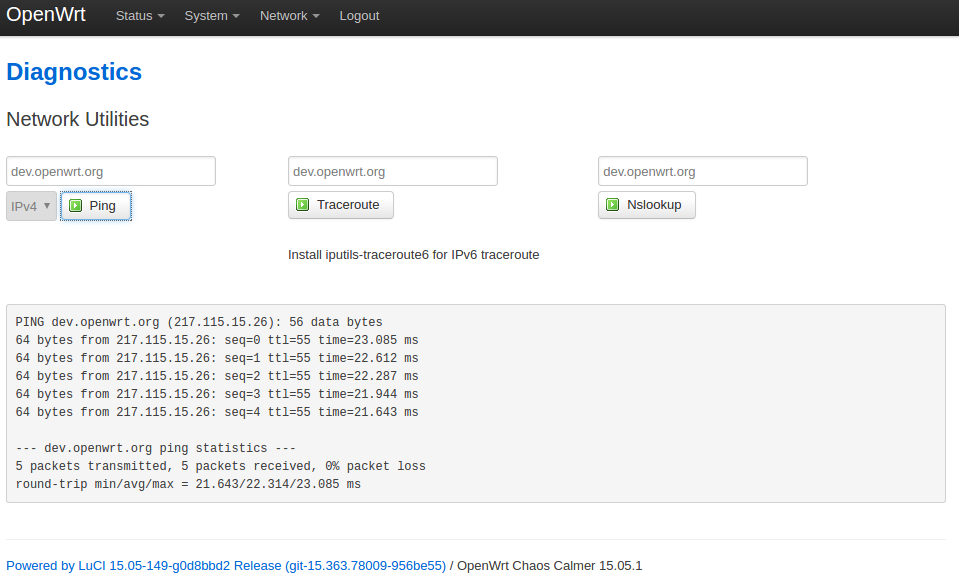
- Go to Network/Diagnostics
- Click on Ping
If the ping was successful it should result in something like shown on the right.
8. Install relayd on router
- With the SSH client of your choice (e.g. PuTTY) connect to your router using ip address 192.168.15.1. Rember to connect as user root. In linux for example you would have to connect like
ssh root@192.168.15.1
- Enter the password you set for OpenWrt in step 4
- Do an pkg update:
opkg update
- Install relayd
opkg install relayd
- Install relayd protocol for LuCI
opkg install luci-proto-relay
- Activate relayd:
/etc/init.d/relayd enable
- End SSH session:
exit
9. Configure bridge via web GUI
10. Adjusting firewall rules
In the menu go to Network/Firewall
- In the Zones section Add
- In the Name field enter bridgezone
- In the Forward dropdown choose accept
- In the Covered networks section check lan: and wwan:
- Anything else stays unchanged
- Click Save & Apply
11. Restart router and test
- In the menu go to System/Reboot
- Click Perform reboot
Your setup is now finished. Any device that is connected to a port of the router (except the WAN port) should now behave like it would be directly connected to the LAN by wire.
To test this with my notebook I did the following steps:
- Disabled my wifi adapter
- Set my ethernet connection back to DHCP
The result is that my central DHCP server gave me a new ip address and I have full access to the internet and all devices in my local network.
Exactly what I wanted. This way I can extend my network to wire-only devices even when there is no network socket available.
Mission complete 🙂
Closing remarks
Remember that the configured router has the static ip address 192.168.15.1 which is very likely not reachable in the local network, e.g. because it has subnet 192.168.1.0/24. If you want to access the router itself, e.g. to make changes to the configuration like connecting to a different wifi network you would have to set the ip of your computer to 192.168.15.2 so it would be able to connect to 192.168.15.1. Additionally the router is configured to ask for an own ip address via DHCP (via interface WWAN). So you may lookup the address and connect to that ip. This works from any device in the network but the ones that are connected directly to the ports of the router.
Was this article helpful?
Consider buying me a coffee to keep my brain fueled 🙂
исходные данные
основной роутер имеет ip 192.168.1.1, на роутере настроен выход в Интернет
канал wifi зафиксирован на основном роутере (в примере 13-канал)
роутер на LEDE/Openwrt имеет ip 192.168.1.1, подключен к ПК с помощью кабеля в разъем LAN
настройка роутера
1. зайти в настройки роутера, перейти в «Сеть—Интерфейсы»
2. отредактировать интерфейс LAN
3. изменить ip адрес на 192.168.10.1, нажать «сохранить и применить»
4. произойдет применение настроек, на некоторых версиях проошивок в течение 30 секунд нужно зайти по новому ip 192.168.10.1 (иначе произойдет откат настроек по изменению ip-адреса), если Вы не успели, то дождаться появления предупреждения и выбрать «Применить без проверки»
5. зайти в настройки роутера по новому адресу 192.168.10.1, перейти в «Сеть—Wi-Fi»
6. нажать «Изменить», чтобы отредактировать настройки точки доступа wifi
7. на странице настроек:
— включить wifi точку (если выключена, нажав кнопку «Включить», при включенной точке wifi кнопка будет «Отключить» — тогда ее не нужно нажимать)
— выбрать канал как у основного роутера (в примере 13 канал)
— настроить имя сети (ESSID), шифрование и пароль (можно задать такое же имя и пароль wifi как у основного роутера)
— проверить, что в поле «сеть» выбрано «lan»
— нажать «сохранить и применить»
8. на странице «Сеть—Wi-Fi» нажать «Поиск» для поиска точки wifi основного роутера
9. выбрать точку wifi основного роутера и нажать «Подключение к сети»
10. на следующей странице обязательно снять отметку (убрать «галочку») с «Заменить настройку беспроводного соединения», ввести пароль от точки wifi основного роутера, нажать «применить»
11. на следующей странице нажать «сохранить и применить»
12. если все данные указаны правильно, то на странице «Сеть—Wi-Fi» будет показан статус подключения к основному роутеру в качестве клиента wifi
на странице «Сеть—Интерфейсы» появится новое подключение WWAN, на котором будет получен ip-адрес от основного роутера, на данном этапе на роутере уже должен быть Интернет (необходимо проверить выход в Интернет, если выхода нет, значит где-то допущена ошибка или основной роутер не имеет выхода в Интернет)
13. перейти в «Система—Программное обеспечение»
14. обновить списко пакетов для установки, нажав «Обновить списки», при удачном обновлении должны загрузиться списки пакетов
15. установить пакет «relayd», для этого в поле «Загрузить и установить пакет» ввести relayd и нажать «ОК»
при удачной загрузке и установке пакета отобразится соответствующая запись
16. аналогично установить пакет «luci-proto-relay», для этого в поле «Загрузить и установить пакет» ввести luci-proto-relay и нажать «ОК»
——————————————————
пакеты также можно установить через консоль SSH (если пакеты установлены через веб-интерфейс, то через SSH устанавливать не нужно), для этого:
1) подключиться к роутеру по SSH, например через Putty (ip 192.168.10.1, логин: root, пароль: пароль от роутера)
2) выполнить команду
opkg update
3) установить пакеты командой:
opkg install relayd luci-proto-relay
——————————————————
17. перейти в «Сеть—Интерфейсы», добавить новый интерфейс
18. указать имя интерфейса (произвольно, в примере имя «repeater»), выбрать протокол «Мост-ретраслятор»
19. на следущей странице указать следующие настройки:
— «Локальный IPv4 адрес» — 192.168.1.4 (можно и другой из подсети основного роутера 192.168.1.х)
— «Ретраслятор между сетями» — выбрать «lan» и «wwan»
— на вкладке «Настройки межсетевого экрана» выбрать lan в поле «Создать/Назначить зону сетевого экрана» (зеленым цветом)
— нажать «сохранить» (НЕ «сохранить и применить»)
20. на странице «Сеть—Интерфейсы» отредактировать интерфейс WWAN
21. на вкладке «Настройки межсетевого экрана» выбрать lan в поле «Создать/Назначить зону сетевого экрана» (зеленым цветом), нажать «сохранить» (НЕ «сохранить и применить»)
22. на странице «Сеть—Интерфейсы» отредактировать интрефейс LAN
23. «IPv4 адрес» указать как в пункте 19, т.е. 192.168.1.4, ниже в настройках «DHCP-сервер» отключить DHCP, поставив отметку «игнорировать интерфейс», нажать «сохранить и применить»
24. при необходимости перезагрузить роутер, после загрузки можно зайти в настройки роутера по адресу 192.168.1.4
клиенты подключенные к роутеру (репитеру) получают ip-адреса от основного роутера и находятся в одной подсети с клиентами подключенными как к репитеру, так и к основному роутеру, общие ресурсы в локальной сети будут доступны на всех клиентах.






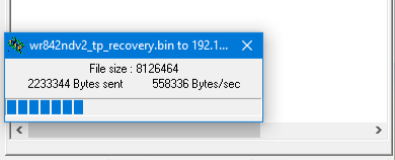




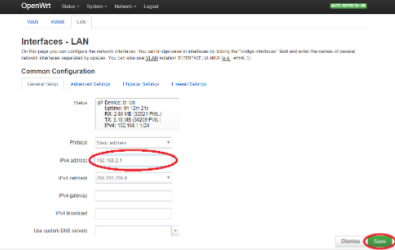

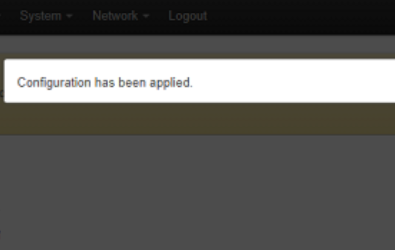
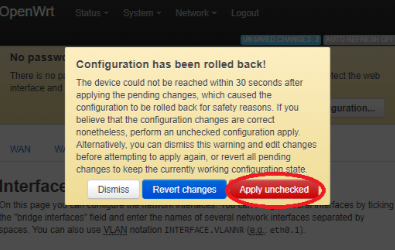
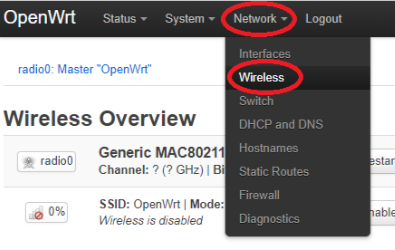
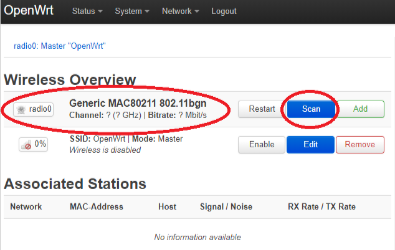


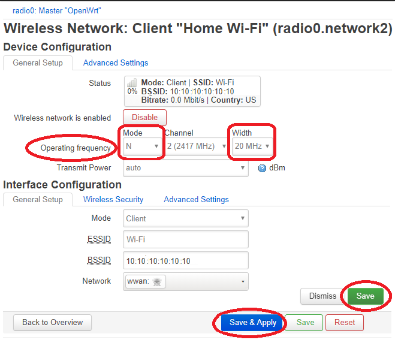

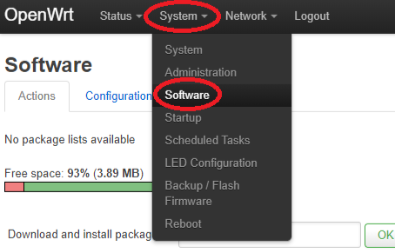
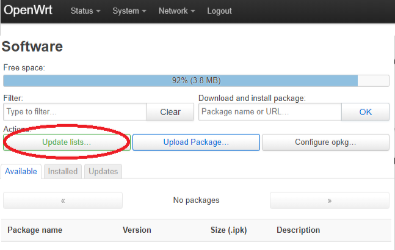




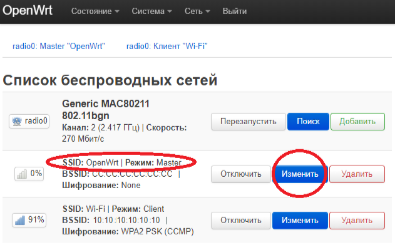

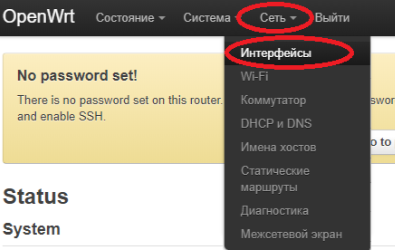

























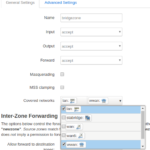 In the menu go to Network/Firewall
In the menu go to Network/Firewall






























